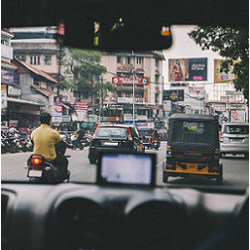
What hits a visitor to India first, quite literally, is the traffic. The combination of inadequate road infrastructure, increasing vehicle population, and poor driver training and discipline makes for a chaotic and often deadly mix. The result is a high rate of road accidents, with the estimate of fatalities ranging from one every four minutesa to over 238,000 each year.b
There is much ongoing work in academia, industry, and startups on using artificial intelligence (AI) and Internet of Things (IoT) technologies to improve the situation. The general goal is to have affordable technologies that work with humans through effective monitoring and feedback, rather than replacing humans through full autonomy.
The road and traffic conditions in India, which are quite different from those in the developed world, present interesting challenges (see Figure 1).

Figure 1. The traffic scene at a chaotic intersection with heterogeneous vehicles. Source: Nericell project; http://bit.ly/2MH6S6p.
Road infrastructure. The road infrastructure has largely grown organically, without the benefit of long-term planning. It is of uneven quality, with safety hazards such as potholes, poor lighting, and inadequate signals and signage. Therefore, monitoring of the infrastructure to identify such hazards is quite important.
Vehicles. For cost reasons, vehicles often lack advanced features such as Advanced Driver Assistance Systems (ADAS). Also, the mix of vehicles tends to be very heterogeneous, spanning two-wheelers (for example, scooters and motorcycles), three-wheelers (for example, auto rickshaws), four-wheelers (cars), and larger vehicles (trucks, buses); in fact, it is not uncommon for even pedestrians to share the road space with vehicles. The heterogeneity in vehicle sizes and speeds often leads to a chaotic flow of traffic, far removed from adherence to lane discipline.
Drivers. Driving discipline is generally lacking, with drivers often cutting corners to “get ahead.” Part of the reason for this is that driver training and license testing lack thoroughness; by one estimate, 59% of driver licenses in India were issued without any test being taken at all.c
Research Examples
We touch on just a few examples of research inspired by this unique mix of conditions and constraints.
Datasets of Indian roads. With data being the fuel for AI research, there are efforts under way to assemble and release an Indian roads dataset.d This is helping to benchmark computer vision techniques on the unstructured Indian road conditions. It is also helping spur the development of new techniques for such data collection, such as low-cost inspection of road infrastructure (potholes, signage, and street lights) using computer vision and inertial sensing.
Driver training, testing, and assistance. There is much interest in using smartphones instead of special-purpose devices to monitor drivers and their driving, with a view to improving safety through effective feedback. A specific example is automated driver license testing, with tracking using a windshield-mounted smartphone in place of expensive infrastructure (like pole-mounted cameras) to make testing comprehensive and cost-effective (Figure 2).

Figure 2. Tracing the trajectory during a parallel parking test (blue = forward, red = reverse) using a windshield-mounted smartphone, which analyzes outside and inside views concurrently. Source: HAMS project; http://bit.ly/2ZseQXC.
Autonomous driving. While autonomous driving in India is likely far off because of the challenging road conditions, work is being done to enable autonomy for specific purposes in confined environments; for example, cargo vehicles at an airport.e There are also initiatives in place to spur research in autonomous driving more broadly through competitive grand challenges.f
The general goal is to have affordable technologies that work with humans through effective monitoring and feedback, rather than replacing humans through full autonomy.
Promising directions for ongoing and future work include technologies to aid traffic enforcement (for example, ticketing using automatic license plate reading), for pedestrians and two-wheelers (which dominate traffic and account for a disproportionate share of fatalities), and for effective simulation and what-if analyses.g



Join the Discussion (0)
Become a Member or Sign In to Post a Comment